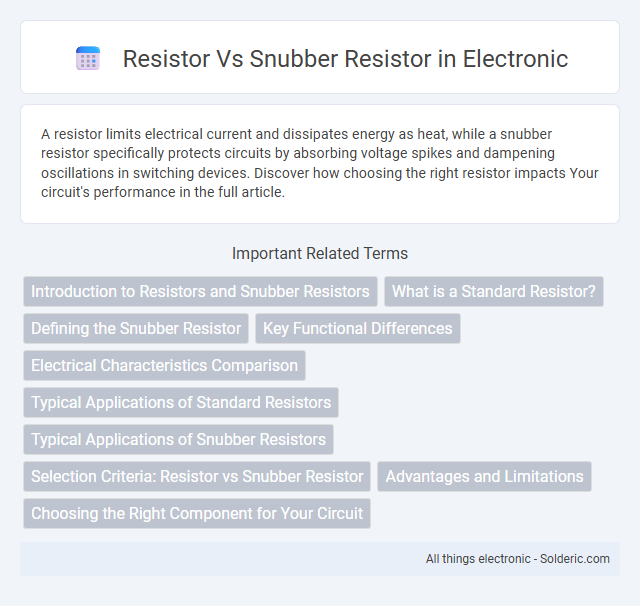A resistor limits electrical current and dissipates energy as heat, while a snubber resistor specifically protects circuits by absorbing voltage spikes and dampening oscillations in switching devices. Discover how choosing the right resistor impacts Your circuit's performance in the full article.
Comparison Table
| Feature | Resistor | Snubber Resistor |
|---|---|---|
| Primary Function | Limit current and divide voltage in circuits | Suppress voltage spikes and absorb transient energy |
| Typical Use | General current control, voltage division, biasing | Protection in switching circuits, reducing electromagnetic interference (EMI) |
| Power Rating | Typically low to medium, based on circuit requirements | Higher power rating to dissipate transient energy |
| Construction | Standard resistor materials (carbon, metal film) | Often combined with capacitor or diode in snubber network |
| Location in Circuit | Anywhere current control or voltage division is needed | Across switches, transistors, or inductive loads |
| Functionality in Transient Suppression | Minimal or none | Critical component to reduce transient voltage spikes |
Introduction to Resistors and Snubber Resistors
Resistors regulate electrical current by providing a precise amount of resistance to control voltage and protect circuit components. Snubber resistors specifically function within snubber circuits to suppress voltage spikes and transient noise caused by inductive loads, enhancing the reliability and lifespan of switching devices. These components are crucial in power electronics, ensuring consistent performance and protection in complex electrical systems.
What is a Standard Resistor?
A standard resistor is a passive electrical component designed to provide a fixed resistance value, accurately controlling current flow and voltage levels in circuits. It is commonly made from materials such as carbon film, metal oxide, or wire wound, with resistance typically specified in ohms (O) and tolerance indicating precision. Unlike snubber resistors, which are specifically employed to suppress voltage spikes and manage transient energy, standard resistors serve general-purpose functions in electronic devices for stable operation and signal conditioning.
Defining the Snubber Resistor
A snubber resistor is a specialized component used in electrical circuits to suppress voltage spikes and dampen oscillations caused by inductive loads during switching. Unlike a standard resistor that primarily limits current flow, the snubber resistor works in conjunction with capacitors or diodes to protect sensitive devices from transient voltage surges. Its precise resistance value and power rating are critical for effective energy dissipation and improving circuit reliability.
Key Functional Differences
A resistor primarily limits current flow and voltage within a circuit to protect components and stabilize performance. Snubber resistors, combined with capacitors, specifically control voltage spikes and suppress transient oscillations in switching circuits, enhancing the lifespan of sensitive devices. Understanding these key functional differences helps you choose the right resistor type for effective circuit protection and noise reduction.
Electrical Characteristics Comparison
Resistors primarily provide a fixed electrical resistance used to control current and voltage in a circuit, with specifications such as resistance value, power rating, and tolerance being critical. Snubber resistors, integrated into snubber circuits, are designed to absorb voltage spikes and dissipate transient energy, featuring higher power ratings and faster response times to protect sensitive components. Your choice should consider the electrical characteristics like transient suppression capabilities and energy dissipation to ensure optimal protection and performance.
Typical Applications of Standard Resistors
Standard resistors find typical applications in voltage division, current limiting, and signal conditioning within various electronic circuits. These components are essential in optimizing performance and protecting delicate elements by controlling current flow and stabilizing voltage levels. Your projects benefit from standard resistors' reliability in general-purpose energy dissipation and circuit tuning tasks.
Typical Applications of Snubber Resistors
Snubber resistors are commonly used in power electronics to protect switching devices such as MOSFETs and IGBTs from voltage spikes caused by inductive loads during switching events. These components are crucial in motor drives, power supplies, and inverter circuits where they dissipate energy and reduce electromagnetic interference (EMI). Your circuit's reliability and lifespan improve significantly by incorporating snubber resistors to manage transient voltages effectively.
Selection Criteria: Resistor vs Snubber Resistor
Resistor selection focuses on parameters like resistance value, power rating, tolerance, and temperature coefficient to control current and voltage in circuits effectively. Snubber resistor selection prioritizes energy dissipation capacity, surge current handling, and compatibility with snubber capacitor to protect switching devices from voltage spikes and reduce electromagnetic interference. Understanding these criteria ensures your circuit operates reliably under normal and transient conditions by choosing the right resistor type for each application.
Advantages and Limitations
Resistors provide basic current limiting and voltage drop functions with simple design and low cost but may cause excessive heat dissipation in high-frequency switching applications. Snubber resistors, integrated with capacitors or diodes, effectively suppress voltage spikes and reduce electromagnetic interference, enhancing component longevity and circuit reliability. Your choice depends on balancing straightforward current control against the need for transient protection and noise reduction in power electronics.
Choosing the Right Component for Your Circuit
Choosing the right component for your circuit requires understanding the distinct roles of a resistor and a snubber resistor. Standard resistors primarily control current and voltage levels, while snubber resistors are designed to suppress voltage spikes and transient noise in switching circuits. Selecting a snubber resistor with appropriate resistance and power rating ensures protection for sensitive components and enhances circuit reliability under high-frequency or inductive load conditions.
resistor vs snubber resistor Infographic

 solderic.com
solderic.com